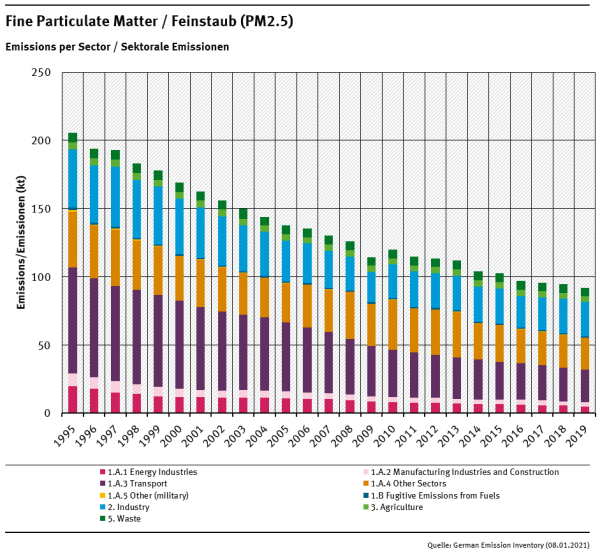Table of Contents
Explanation of Key Trends - Fine Particulate Matter (PM₂.₅)
Obligations
Germany has made a commitment to reduce particulate matter emissions. The revised Gothenburg Protocol and the revised NEC Directive both define emission reduction targets relative to a 2005 base year, mandating 26% (2020) and 43% (2030) reductions respectively.
While Germany's compliance with these obligations is not discussed here, further information on this subject can be found in Chapter 9 - Projections and Chapter 11 - Adjustments and Emission Ceiling Exceedance.
Main drivers
Total PM₂.₅ emissions dropped by 55.3% between 1995 and 2019. The Main Drivers for PM₂.₅ emissions are Fuel Combustion (NFR 1.A) with 72.5% of total 1995 emissions and a 63% reduction between 1995-2019 and as a sum the Industrial Processes (NFR 2) with about 21% of total 1995 emissions and a 41% reduction between 1995-2018.
Within both National totals and NFR 1.A, Transport (NFR 1.A.3) is responsible for the biggest part of PM₂.₅ emissions. Here, about 77% of 2019 PM₂.₅ emissions are induced by Road Transport (NFR 1.A.3.b), caused by two third directly by fuel consumption (NFR 1.A.3.b.i - v) and the other third by road abrasion and tyre and brake wear (NFR 1.A.3.b.vi - vii).
PM₂.₅ Emissions 1990-2019
| Total Emissions (kt) | Trend: latest compared to | |||||||||||||
|---|---|---|---|---|---|---|---|---|---|---|---|---|---|---|
| 1995 | 2000 | 2005 | 2010 | 2011 | 2012 | 2013 | 2014 | 2015 | 2016 | 2017 | 2018 | 2019 | 1995 | last years |
| 169 | 138 | 120 | 120 | 115 | 114 | 112 | 104 | 103 | 97 | 96 | 95 | 92 |  -55.3% -55.3% |  |
